最新译林牛津版初中英语七年级上册课程Unit 6 公开课教学设计
- 格式:doc
- 大小:33.00 KB
- 文档页数:5

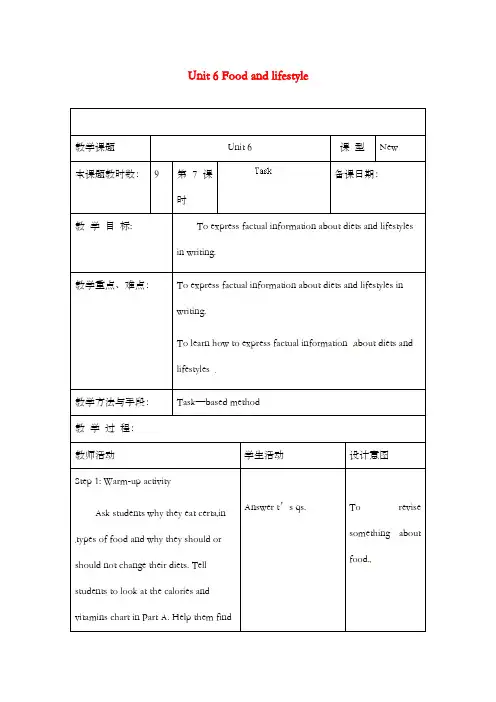
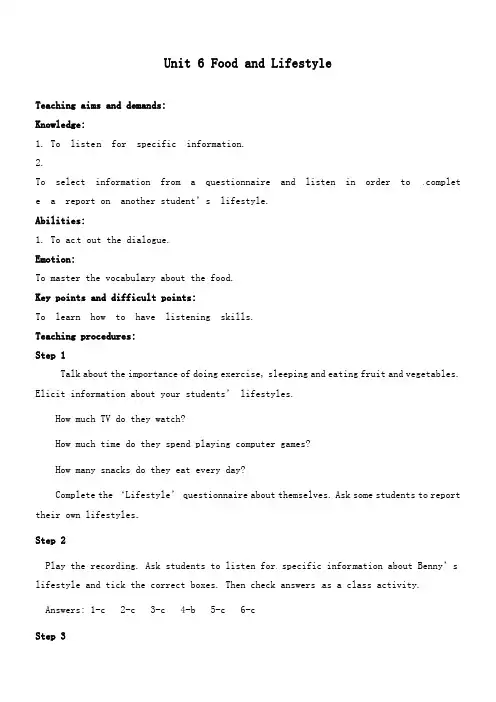
Unit 6 Food and LifestyleTeaching aims and demands:Knowledge:1. To listen for specific information.2.To select information from a questionnaire and listen in order to complet e a report on another student’s lifestyle.Abilities:1. To ac t out the dialogue.Emotion:To master the vocabulary about the food.Key points and difficult points:To learn how to have listening skills.Teaching procedures:Step 1Talk about the importance of doing exercise, sleeping and eating fruit and vegetables. Elici t information about your students’ lifestyles.How much TV do they watch?How much time do they spend playing computer games?How many snacks do they eat every day?Complete the ‘Lifestyle’ questionnaire about themselves. Ask some students to report their own lifestyles.Step 2Play the recording. Ask students to listen for specific infor mation about Benny’s lifestyle and tick the correct boxes. Then check answers as a class activity. Answers: 1-c 2-c 3-c 4-b 5-c 6-cStep 3Ask students to enter Benny’s score and their own score in the table in Part A3. Students analyze the health scores for Benny and themselves. Read out three categories. Ask students to put up their hands for each category. Count the number of students in each category to see how healthy or unh ealthy the class is.Write a class profile on th e blackboard with the number of students for each category. Student s could put up this information for class display.Step 4:Listen and answer some questions.Read after the tape.Make a similar dialogue.Step 5:补全对话Sandy: ________ _________ do you exercise?Tommy: Less than twice a week.Sandy: ________ _________ do you eat fruit and vegetables?Tommy: Very often.Sandy: _______ _________ do you do your homework?Tommy: Less than two hours.Sandy: ________ _________ TV do you watch every day?Tommy: More than an hour.Answers: How often, How often, How long, How muchStep 6:Oral work: Go on with the question naire, do it with your families.Written work: Teachers can assign this part according to their own conditions.。

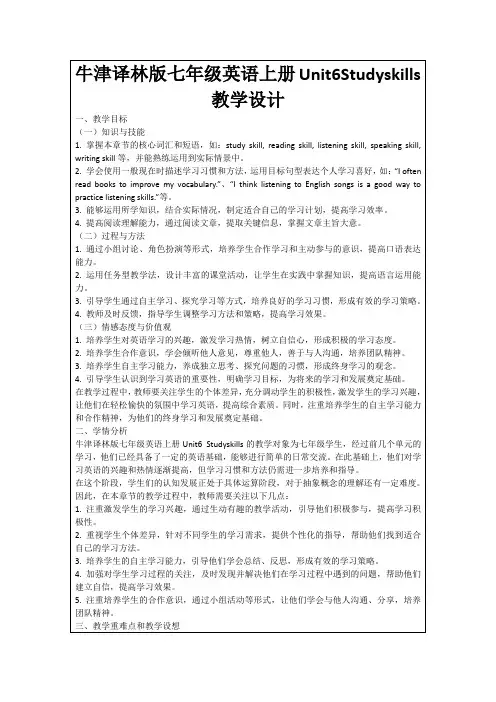
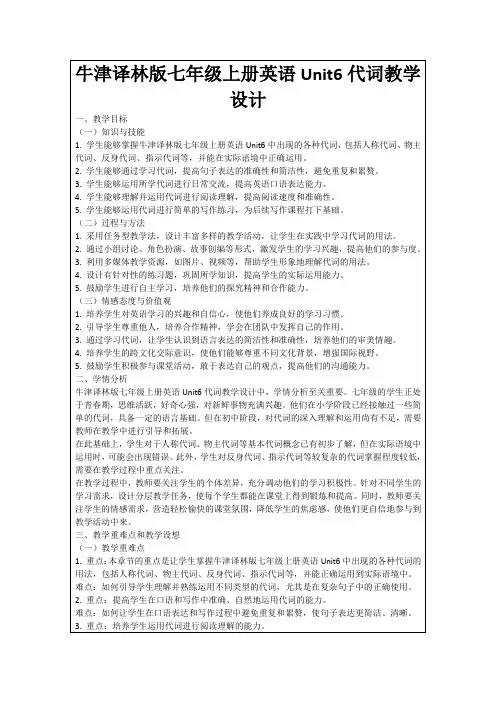
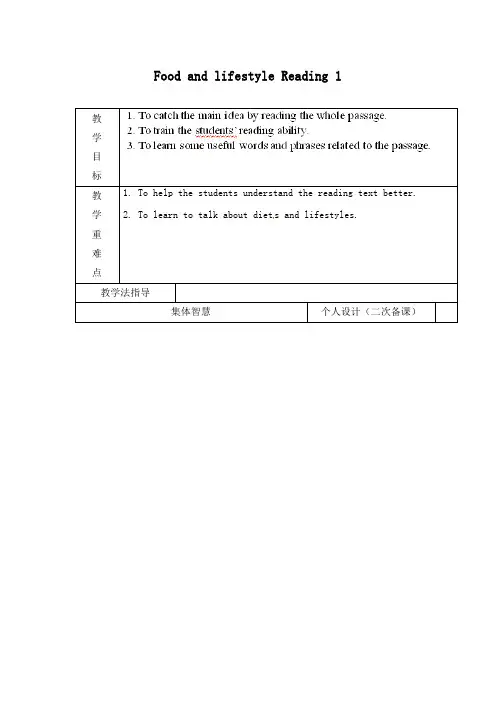
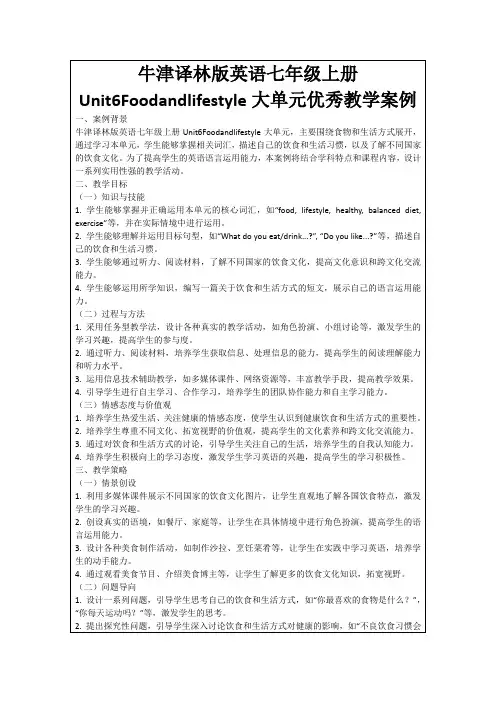
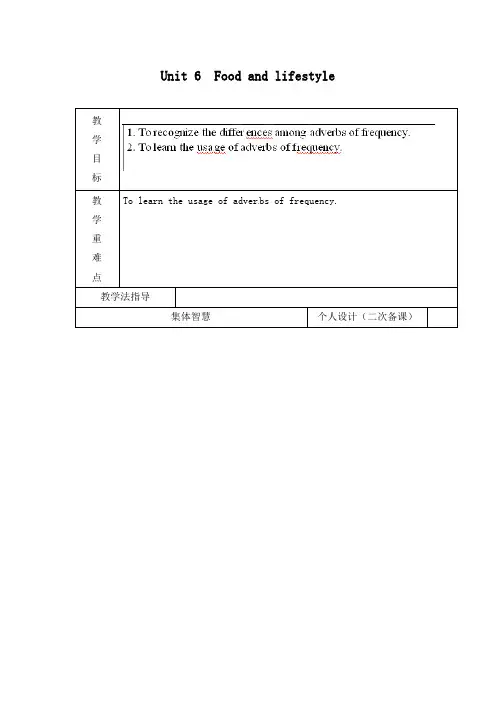
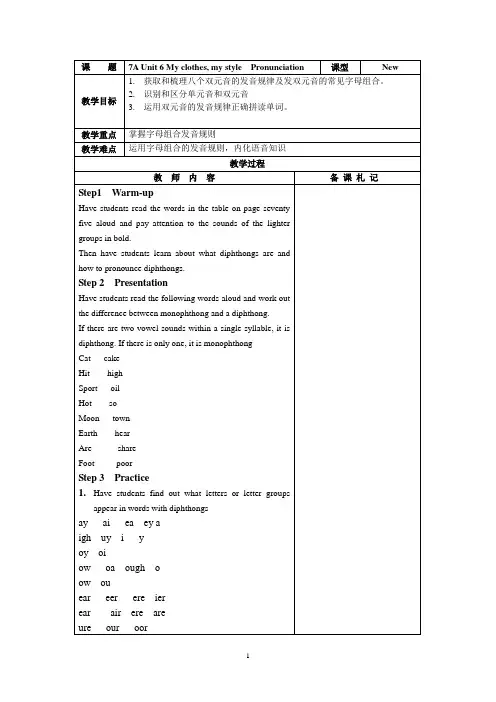
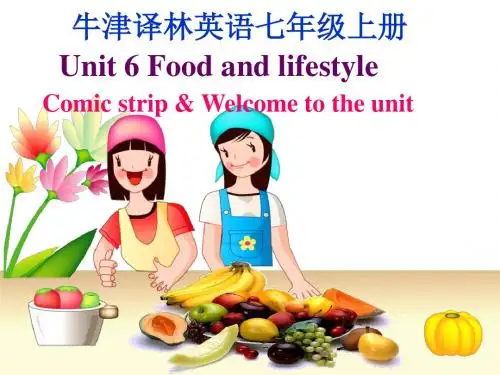
《Unit 6 Food and lifestyles Integrated skills》教案Teaching aims:A)1.To get some information by reading and listening to the tape.2.To know about one’s lifestyle.B) 3.To master the phrases of ordering meals.Four skills:Words:Less than total number score point more order menu taste Phrases:Less than more than take a walk have a look at all right Sentences:How long do you sleep every night?You need to exercise more and eat more healthy food .What would you like to orderWould you like some vegetables?Three skills:Phrases:Three times a weekStep1: GreetingsStep2; Presentation1.Show a video about my lifestyle, let students watch the video .While students are watching the video, show some new words on the Bb.T: Today we’re going to talk about how healthy you’re and how to keep fit.Do you think you’re healthy? Can you tell me how to be healthy? Ask severa l students to show their answers.2.Show a video about my lifestyle, after watching it . Ask students :Do you think mylifestyle is healthy? Why?While asking and answer questions ,teach the new phrases ,such as:I sleep less than 7 hours , right? How long do I sleep?T:I like walking ,so I always walk more than an hour ,about an hour and a half.Write “less than” and “more than”on the blackboard. 解释“less than”and “more than”.3.Ask students : How often do I exercise ? How long do I sleep every day?解释How long and How oftenT :We often use words like sometimes seldom often never and three times a week to answer “How often”questions .And we answer a “How long”questions with a period of time such as an hour two days and three years.4. Have a discussion with your partner and find out if they have a healthy lifestyle. Step3: Listening1.Now let see Benny’s lifestyle. Listen to an interview with him and tick the correct boxes.2.Listen to the tape again and check the answers together.Speak up:What would you like to order?Step4:Presentation1. Millie and her cousin Andy are ordering food at a re staurant ,listen to theirconversation, and tell me what Andy and Millie have for dinner.2. Listen to the tape and ask students to read after the tape.3. Work in pairs and talk about what you would like to have. Use the conversationbelow as a modelStep5 Homework必做题一.翻译下列词组:1.多久一次2.多长时间3.不到一小时4.二个多小时5.需要多锻炼6.看一看菜单7.如何保持健康8.苹果汁味道不错二、单项选择( ) 1. --- do you usually do at the weekend?---I usually do some cleaning.A. WhenB. HowC. WhatD. Where( ) 2. -- do you watch TV every day?--Less than an hour.A. WhenB. What timeC. How longD. How often( ) 3. Benny,let’s talk about how _____you are and how to keep .A .health,fit B. healthy,fitC. health,health D. healthy,health( ) 4. ---How often do you exercise? --- .A. A weekB. OnceC. TwiceD. Once a week选做题三、根据句意及首字母或汉语提示写出正确的单词1.Your lifestyle is not (健康的) .2. You need (锻炼) more.3. Eddie likes (eat) and (sleep).4. How often you (锻炼)?5. What (别的,其他的) would you like?6. What (别的,其他的) things would you like?四、补全对话A:Hi,Millie. B:, Lilly.A: would you like to eat? B:Some soup firs t, . A:Would you like rice?B:No, . like some fish.A:What some chicken?B: OK,just a little. Mmm, tastes good.A:Would you like some chicken?B:No, I’d some vegetables.A:OK, anything ? B:I’m full, thanks.。
一、年级:七年级二、教学内容: 7A Unit 6 Fashion三、课型: Checkout四、教学目标1.知识目标:学生掌握本单元教授的语法和语言知识。
2.能力目标:学生通过语言知识的学习,能正确运用本单元所学语法和词汇。
3.情感目标:学生在完成练习的过程中对自己的学习有个客观的评价,以获得成就感,并树立学好英语的自信心。
五、教学重难点1.重点:掌握和运用本单元的词汇、句型和语法。
2.难点:能正确运用表达事情发展顺序的5个词,掌握描绘服饰的Step 1 Revise grammar1. Do you get up early every day? What do you usually do on week days? Now let’s see Tom’s day and tell me his daily activities.各类词。
This is Tom’s dayFirst, _____________________.Then, ___________________.Next, ___________________.Afterwards, _______________.Finally, ___________________.2. Tom’s sister is very hungry, so she says:So watch the correct order of making a cake and rearrange the following sentences.a.__________ bake(烘烤) it for 20 minutes at 180°Cb. ____ put the mixture into a baking tin.c. ____ mix 100 grams of sugar and butter into 200 grams of flour .d. _____ beat two eggs. Add the eggs to the mixture.e. ______ wait for the cake to cool. Put the chocolate on the top of the cake.3. Rule outWe use first, then, next, afterwards, finally to tell the order of events.Can you make a cake for your birthday party next time?May I take part in your birthday party and have a piece of cake?4. Rule outWhen we want t o ask for permission from other people, we use________ and _______ .Step2 Practice句型转换1. I can sing some Eng lish songs. (否定句2. You may have a piece of bread.(疑问句)3. May I ask you any questions? (否定回答)4. You can watch TV for one hour. (对画线部分提问)Step3 A quizPlease turn to page 105 and complete the conversation in Part A.Step 4 Language points1. Look at the pictures and answer the following questions.Who is she ? a modelWhat is she doing? having a fashion showfashionableHow many colours can you see?Do you know what clothes young men would like to wear?Do you know what clothes young ladies would like to wear?2. Please describe the clothes in the pictures with the words we have learne d in this unit.P1: This is a _____.It’s made of ______.It’s ___________P2: They are ________.They are made of _____.They look nice on anyone.P3: They are ________.They are made of _____.We wear them in ______, _______ and ______.They can keep us ______.P4: They are _______.Most of them are made of______.We usually wear them in _______.What are they ?What are they made of?Step 5 Practice请你来做服装设计师 (group or pair work)1. Suppose your class will go on a trip to the park.What are you going to wear?2. Suppose Christmas is coming! Your teacher wants to have a party to celebrateit.What are you g oing to wea r?3. A quiz1.Please complete Millie and Sandy’s conversation in Part B on page 105.4. Try to write out the words you have learned in this unit in this order: clothes, colours, materials.Step 6 Homework1. Put the story into English:早晨起床,我先穿衣服,然后打开收音机听英语。
《Unit 6 Food and lifestyles Welcome to this unit》教案Teaching Goals·A)To learn new vocabulary about food: hamburger, vegetable, carrotB)·To talk about likes and dislikes with regard to food:What food do you like? I like hamburgers.Do you like carrots? No, I don’t like/dislike/hate them. What about fish?Teaching ProceduresStep 1: Warm-up activityWrite new words in the blackboard.Give Ss five questions about the daily diet and ask them to answer them as soon as possible.Do you know what I ate this morning? (S guessing…) Oh, I have eaten milk and egg because they can give me more energy.2. Ask students to name as much food as possible in English and write them on the blackboard and group them. (Teachers can ask the following questions:)a.What food do you have for breakfast/lunch/supper?b.What food do you like? Why?c.What food do you dislike? Why not?d.What food is good for us?e.What food is bad for us?f.What Chinese food do you know?g.What Western food do you know?h..Do you like Chinese food or Western food? Why?Step 2: Presentation1. Show the Ss the groups the food and let Ss say the names of them together.2.Group Discussion: Divide Ss into groups and discussa.‘What is your favourite food/meat/ drink/vegetables?’b.‘ Why do you love/ like them?’3.Discuss about ‘What food you dislike/ hate?’ and ‘ Why do you dislike/ hate them?’ Examples:T: What food do you love/like?/ What is your f avourite food?S: I love/ like ….T: What food do you dislike/ hate?S: I dislike/ hate ….Step 3: Practice1. Ask students to write the food they like or dislike in the table of Part A2. Ask students to make up a conversation, use the one in Part B as an exampleA: I like bananas. What food do yo u like?B: I like hamburgers.A: Do you like carrots? They are my favourite.B: No, I dislike them. What about fish?A: I like fish. It is healthy. I don’t like eggs. What about you?B: I hate eggs.3. Ask a few pairs of students to r ole-play the conversation in front of the class.4. Ask students to talk about their family as well, e.g., My sister loves ice cream. My father hates chocolate.Step 4: Presentation①pair work:A: What do you usually eat for breakfast/lunch/ supper?B: I usually eat…. for breakfast/ lunch/ s upper.A: What food do you like/ love?B: I love / like…A: What food do you dislike/ hate?B: I dislike/ hate…\②Report time: Ask students to make reports what they o r their partners like or dislike to the class.Step 5: Listen and answer1.What’ll Eddie eat for lunch? (a hamburger)2.Is he always hungry?( Yes)3.Why?(He needs a lot of energy.)4.Does he often do some exercise/ exercise?(never)5.Why does he need a lot of energy? (He walks to his bowl many times a day.)6.What do you think of Eddie? (He’s lazy and likes eating.)7.Is he healthy?Step 6: Act outAsk students to role-play the conversationStep 7: DiscussionAsk students to discuss how to be a healthy person according to Comic strip. ( exercise more and eat healthy food, etc.)Step 8: SummaryT: In this period, we have learned about the names of some food and talked aboutwhat food we like and dislike. We also learned a comic strip which showed us themain points of this unit.Step 9: Consolidation exercises句型转换1.T he little boy is very hungry now. (改为一般疑问句)2.I t’s lunchtime.(写出两个同义句)3.S he needs two oranges.(对划线部分提问)4.E ddie walks to his bowl many times a day.(同上)Answers: 1. Is the little boy very hungry now?2. It’s time for lu nch./ It’s time to have lunch.3. What does she need?4. How often does Eddie walk to his bowl?Step 10: HomeworkOral work: Revise this period, listen, repeat and recite Comic stripRecite the new words, phrases and sentence patterns.Preview reading必做题:词汇1.中午2.柠檬3.牛肉4.猪肉5.健康6.胡萝卜7.零食8.糖果9.巧克力10.保持11.肉12.生活方式翻译词组1. 吃一个汉堡2. 对我们有益3. 十点半4. 给我十个苹果5. 各种各样的食品选做题完成对话(每空一词)It’s n. Hobo and Eddie are talking about what to eat. Eddie would like to have a h_______ ____. But Hobo thinks hamburgers are not g __________ for our health, and that Eddie should have an a ,Because an apple a day k the doctor away . Eddie agrees(同意), but he needs t . Do you think that he can eat ten apples for just one meal? No, I don’t think so. I think we should make a h diet for Eddie. And we should have healthy l .。
牛津英语预备课程第六单元教案Unit 6 In the park 一、教学内容词汇:park, between, tree, flower, under, in front of, gate, bird, cl imb, swim, where, here, open, near, house, boat, zoo, animal, shop, s ome, walk, ice cream, lake, pick, feed, left, right, cafe, in the mid dle of, start, grass, miss, turn, answer, question, throw, win, dice 句型:We are in ABC Park. I'm between the trees. Lily is behind the f lowers. Where's the bird? It's in the tree.Where are the students? Th ey're on the playground. Don't climb the tree. Here's the gate.二、教学目标和要求1. 掌握四会词汇和句型。
2. 掌握介词和介词短语。
3.正确使用否定祈使句。
4.会对表示地点的介词短语提问。
三、教学步骤Step1 Revision1. 听写第五单元的单词。
2. 复习there be 结构的各种句式。
3 .教师利用事物复习上单元的内容。
Step2 Presentation1.条件允许,可以出示一幅公园图,让学生回忆一些与公园有关的名词,如:b ird, tree, flower, lake, chair,grass, boat, animal, cafe, playground 等等。
教师可以用What's in the park? There be.....复习以上单词。
接着用图上的人或物引出问句"Where is/are ......?"然后复习本单元的介词以及它们的短语,如:between, between the trees; behind, behind the flowers; under, under the chair; in front of, in front of the gate.....Step3 P ractice1.利用教室里的实物进行句型练习。
如:Where's the blackboard? It 's on the wall. Where are the books? They're on the desk.2. 做听力复习否定祈使句的构成,并利用本课的动词做口头练习。
四、知识讲解1.in, on, under, behind的含义:in表示“在……里面”,on表示两者接触“在……上面”,under表示不接触“在……下方”,behind表示“在(外面的)后面”。
2.between 的意思是“在......之间”,后面应该跟名词复数。
如:between t he trees, between the bags3.in thetree 与on the tree 都是“在树上”,但前者指不是树本身具有的,而是通过其他途径(如爬行、飞等)而到了树上。
如:My kite is in the tre e.(我的饿风筝在那棵树上。
)There is a ball in the tree.(树上有个秋。
)后者指树本身具有的,on 强调接触。
如:There are some bananas on the tr ee.(树上有些香蕉。
)4. in front of / in the front of 都表示“在....前面”,但从人所处的位置来讲,它们有着很大的区别。
in front of 表示在一物体外部的前面或正前方,即“在......前面”的意思。
例如:There are some big trees in front of the workshop.(车间的前面有几棵大树。
)in the front of 表示“在.....前部” 的意思,常有内外之别。
如:There is a big blackboard in the front of the classroom.(教室前面有个大黑板。
)5. on the left 与on the right 分别指“在左边”和“在右边”,但是如果想表达“在......左边或右边”,需要在后面加of ,类似的词有in the middle ( of ).6. Where's...?及其回答。
如要询问某物或某人在哪里,可能“Where is...?”这一句型。
这一问句的结构与中文完全不同,where一词的意思是“在哪里”。
例如:Where's your pen? It's here. Where is your book? It's here. Whe re is your teacher?这是一个特殊问句,回答时不能用Yes或No回答,而应直接回答。
It (He...) is......五、能力训练1. 翻译词组。
(1)在树之间__________(2)在大门前__________(3)在椅子下面________ __(4)在操场上__________ (5)在学校左侧__________(6)在公园中央___ _______2. 用适空。
(1) __________is your pen? It's__________ my pencil-box.(2) Where __________my pencils? They're on __________ desk.(3) Where __________ the picture? It's __________the wall.(4) Where__________ the balls? They're __________the floor.3.用what, where, how填空。
(1)__________ are you? I'm fine.(2)__________is my bag? It's here.(3)__________ is this? It's a book.(4)__________ grade are you in? I'm in Grade 1.4.英汉互译。
(1)我在八班_______________________(2)I'm thirteen, too._______________________(3) I'm in Class 4. _______________________(4)早上好,王老师。
_______________________(5)三支钢笔_______________________(6)这些苹果_______________________5. 句型转换。
(1) Lucy's coat is on the desk.(对斜体部分提问)____________________ ____(2) My name is Liu Tao.(同上)______________________________________ ____(3) My teacher is thirty.(同上)____________________________________ ______(4) The maps are on the wall.(同上)________________________________ __________(5) My bag is on the chair.(同上)__________________________________ ________(6) They are in her pencil-box.(改一般疑问句)______________________ ___(7) is, big, there, behind, cafe, a, the.(连词成句)________________ _____________(8) There are some flowers in the park..(改一般问句并作否定回答)___ ____________(9) Pick the flowers.(改否定句)____________________________________ ______(10) There are two toilets on the left of the gate.(对斜体提问)____ _____________6. 完成下列对话。
A: Jill, there __________a new park near my school.B: Oh, that's nice. What's in it? __________there any lakes?A: No, there __________, but there__________a zoo.B:__________there many, and there__________ lots of small animals, to o.A: What about shops?B: There __________some small shops near the park7. 翻译下列句子。
(1)他在树之间。
__________________________________________(2)那个男孩在门后面。
__________________________________________ (3)在公园不要爬树。
__________________________________________ (4)她在我家门前。
__________________________________________(5)操场上有许多男孩和女孩。
________________________________________ __。